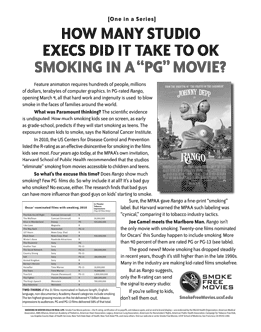March 19, 2011
The FDA Tobacco Products Scientific Advisory Committee released its long-awaited menthol report yesterday, March 19, 2011. The overall conclusions and recommendations in the report are on page 208 of the PDF. There are two major scientific findings, repeated below (broken out into individual statements, but direct quotes, and one recommendation: "Removal of menthol cigarettes from the marketplace would benefit public health in the United States." The TPSAC reached this conclusion based on two more detailed important conclusions:
1. "Menthol cannot be considered merely a flavoring additive to tobacco. Its pharmacological actions reduce the harshness of smoke and the irritation from nicotine, and may increase the likelihood of nicotine addiction in adolescents and young adults who experiment with smoking."
March 13, 2011
Ever since Philip Morris (and other multinational tobacco companies) have gone into the smokeless business, particularly with snus co-branded with cigarettes they have been trying to make claims that promoting smokeless is a good harm reduction strategy. They have even petitioned the FDA to allow them to make explicit health claims in their marketing.
One big problem with all this is that the companies are aggressively promoting "dual use," when smokers would use snus when they couldn't smoke cigarettes and cigarettes the rest of the time (hence Marlboro Snus and Camel Snus). As part of the effort to build this case, Philip Morris researchers published a paper in Nicotine and Tobacco Research last December that reviewed that available literature and concluded " Overall, the concern about dual use appears to be contradicted by the evidence in the literature that dual use of smokeless tobacco and cigarettes may result in reduction in smoking-related harm as smoking intensity is decreased and smoking cessation increases."
March 10, 2011
The youth-rated (PG) film Rango is the smokiest in years, a fact that is attracting a lot of attention.
Here is a chronology of recent events:
• January 19, 2011 | the Motion Picture Association of America (MPAA) announced it had rated a forthcoming Paramount animated feature film, Rango, "PG for rude humor, language, action and smoking."
• Wednesday, February 23 | Having confirmed some of the tobacco imagery in the movie with more than one source, Smoke Free Movies ran this ad in Variety and The Hollywood Reporter.
• Friday, March 4 | Rango opened on 3,900 screens and grossed $38,079,323 through the weekend.
Rango has the most tobacco incidents of any animated film since 101 Dalmatians (1996). Rango delivered nearly 300 million tobacco impressions to theater audiences across the US and Canada in its first three days.
March 2, 2011
Today's MPAA ratings bulletin announces that Weinstein's The King's Speech has been re-rated from "R" to "PG-13 for language." The bulletin notes: "Edited version. Content is different from 'R' rated version...9/15/10."
Re-rating may get Weinstein a sales boost on the DVD release, but an MPAA waiver also allows the re-rated film to be released to theaters to reap post-Oscars® publicity. News:
"We thank the MPAA for their speedy and sensitive consideration of the alternative version of The King's Speech," said [Weinstein] COO David Glasser. "We are thrilled that they have assigned this version a PG-13 rating and are very grateful for the waiver of the 90-day withdrawal period. At this time, [Weinstein] and the filmmakers are discussing the appropriate next steps."
February 23, 2011
Today Smokefree Movies ran a full page ad in Variety and Hollywood Reporter highlighting the fact that the new Paramount animated movie Rango, which will hit the theaters next week, on March 4, featured smoking. Given that the movie is a cartoon, the producers can's use the excuse that the actor insisted on smoking! Any smoking -- even in cartoons -- contributes to youth smoking.
See the full ad here.

